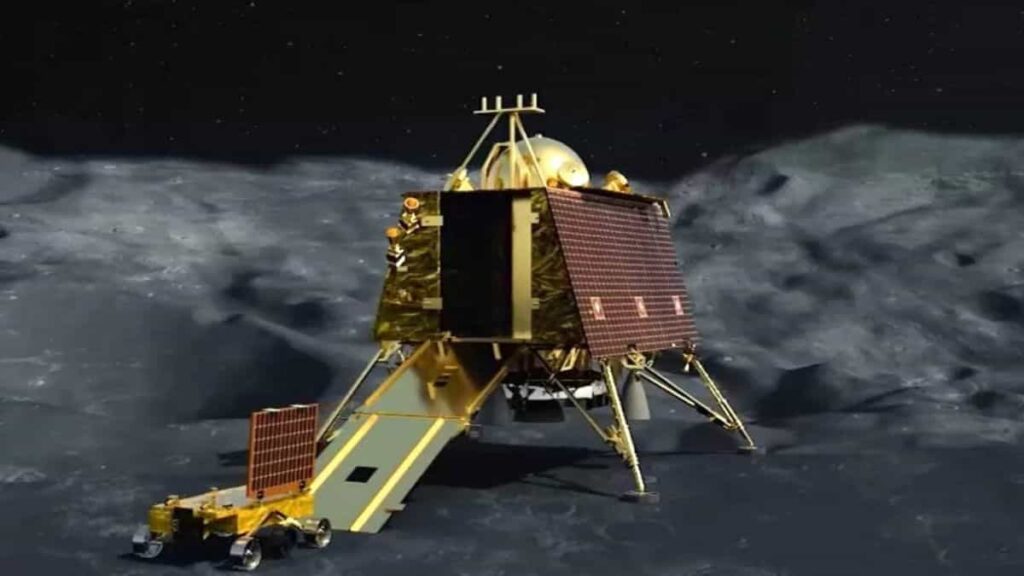Are you curious to know what is the name given to the location where the lander of Chandrayaan-3 touched down on the moon surface? Chandrayaan 3 Landing Point Name is “Shiv Shakti”. India’s Chandrayaan-3 mission successfully landed near the lunar south pole on 23rd August 2023, marking the first time any country has landed in that region. This third Moon mission for India was announced as accomplished by Prime Minister Narendra Modi on 26th August 2023.
- PM revealed that the landing site of Chandrayaan-3 would now be named “Shiv Shakti” in honour of the mission.
- Moreover, the Chandrayaan-2 lander impact place will be called “Tiranga“.
- PM also announced that August 23, the day Chandrayaan-3 successfully landed on the Moon, will be celebrated as the National Space Day of India.
Chandrayaan 3 Landing Point Name
The answer to the question What is the name of the Chandrayaan 3 Landing Point? is “Shiv Shakti”. The landing site now called ‘Shiv Shakti’ holds great significance for humanity and our exploration of space, as it marks the first instance of any nation reaching the far side of the Moon. The data collected by the Vikram Lander and Pragyan rover at this site will be incredibly valuable for helping scientists understand details about the Moon’s atmosphere, surface composition, and overall environment. Reaching this unexplored region provides an opportunity to gain key insights about the lunar surface by analyzing the findings from India’s Chandrayaan-3 mission instruments stationed at ‘Shiv Shakti’.
Attempt Chandrayaan 3 Quiz Now!
Chandrayaan 3 Landing Point Name in Hindi
चंद्रयान-3 की लैंडिंग साइट ‘शिव शक्ति’ नामित (Chandrayaan-3 landing site Shiv shakti point): प्रधानमंत्री नरेंद्र मोदी ने चंद्रयान-3 द्वारा चंद्रमा के दक्षिणी ध्रुव पर सफलतापूर्वक लैंड किये गए क्षेत्र को ‘शिव शक्ति’ नाम दिया है। भारत का तीसरा चंद्र मिशन चंद्रयान-3 ने एक ऐतिहासिक कारनामा करते हुए पहला देश बनकर चंद्रमा के दक्षिणी ध्रुव के अब तक अअनखंडित क्षेत्र में सफल उतरन का दावा किया है। राष्ट्र के नाम प्रधानमंत्री जी ने बताया कि चंद्रयान-3 के इस अभूतपूर्व कामगिरी को स्मरणीय बनाने के लिए उन्होंने इस उतरन बिंदु का नामकरण ‘शिव शक्ति’ किया है।
Who and how are spots on the Moon named?
While India has the rights to name Chandrayaan-3’s landing site, the IAU has final approval authority to make the name official on international lunar maps and databases.
- Naming is overseen by the International Astronomical Union (IAU), the official astronomical naming authority.
- Names are usually proposed by the country or organization responsible for first imaging or visiting a particular site.
- Proposed names then go through a review process by the IAU’s Working Group for Planetary System Nomenclature.
- Names typically honour significant people and achievements in space exploration or science. They often come from mythology or history as well.
- Major structural features like craters, mountain ranges, valleys etc. were among the first named sites based on photos from early orbiters.
- More precise landing missions now allow for naming specific sites where rovers touched down or probes impacted.
- Countries generally have rights to name sites within a small radius where their spacecraft landed or crashed.
- Sites accessed by multiple missions may incorporate names from all contributing countries/agencies.
International Astronomical Union (IAU)
The IAU, founded in 1919, oversees the standardization of celestial object nomenclature according to its website. It comprises various task forces like an executive committee and working groups of professional astronomers worldwide.
Regarding planetary and satellite surface naming, the IAU notes that when first images are obtained of a celestial body, new naming themes are chosen in collaboration with missions. IAU task groups then propose important feature names.
The IAU’s Working Group for Planetary System Nomenclature (WGPSN) ultimately approves proposed names upon review. If approved by WGPSN member vote, the names become official IAU nomenclature, appearing on maps and publications.
Previously in 2020, Chandrayaan-2’s Orbiter images revealed a moon crater that was named ‘Sarabhai Crater’ after Vikram Sarabhai, the father of India’s space program. The crater is approximately 1.7 kilometers deep with walls sloping between 25 to 35 degrees, as observed from its raised rim in Chandrayaan-2 imagery.
Has India ever named any other site on the Moon?
Following India’s 2008 Chandrayaan-1 mission where the probe intentionally crashed on the Moon as part of the mission objectives, the impact site was named “Jawahar Sthal” in honour of the first Prime Minister Jawaharlal Nehru.
According to former ISRO Chairman G. Madhavan Nair, then President and ex-ISRO scientist Dr. APJ Abdul Kalam had questioned how to symbolically note India reaching the lunar surface. Along with an Indian flag carried by the spacecraft’s Moon Impact Probe, Kalam suggested naming the impact site for Nehru given it was his birthday on which the landing took place. Nehru had long championed undertaking scientific developments and research in India. The IAU later approved this name, making “Jawahar Sthal” an officially recognized location on the Moon.
The landing site has been named “Shiv Shakti” by PM Modi.
The International Astronomical Union (IAU) has the final approval for officially naming lunar locations and features, but the discovering country/organization can propose names.
The discovering entity proposes a name which is reviewed by the IAU’s Working Group on Planetary System Nomenclature before final approval. Names typically honour scientific or exploration achievements.
Yes, the impact site of Chandrayaan-1 was named “Jawahar Sthal” in honour of PM Jawaharlal Nehru.
The IAU was founded in 1919 and oversees the standardization of naming schemes and approval of official names for locations and features across the solar system. It works with space agencies and its task groups to coordinate the naming process.
